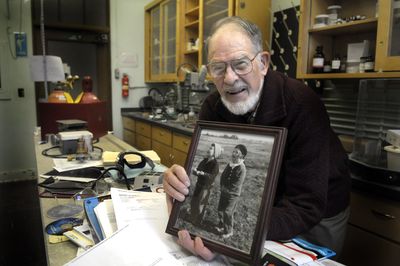After 50 years, chemist still loves a good interaction
WSU professor found livelihood, love and a home on Pullman campus

PULLMAN – It wasn’t Washington State University that hired Don Matteson to teach.
In the fall of 1958, the school on the Palouse was still known as Washington State College.
Fit, bearded and bespectacled, and with hearing aids that help him decipher words spoken over the rattle of ventilation fans, Matteson this year is marking 50 years of teaching organic chemistry at the school that became WSU as he was starting his second year.
“I have former students who are retired,” said Matteson, 76, whose work with organoboron compounds was used by a pharmaceutical company to develop a cancer treatment.
Hiring Matteson at a starting wage of $5,700 was a good investment for the college. He collected research-funding grants that exceeded his salary every year from 1959 through 2006. Since cutting back to half-time about five years ago, he’s donated his salary to the chemistry department to fund a speakers series.
And he and his wife, Marianna Matteson, who retired as chairwoman of WSU’s foreign-language department in 1997, have donated enough money to start endowed professorships in each of their specialties.
“Turns out that professors, while they aren’t paid a whole lot for their expertise … have a good retirement system,” Matteson said. “And we suddenly discovered that we’re in pretty good shape.”
A native of Kalispell, Mont., Matteson was the son of a high school teacher whose subjects included science.
Among other things, Stephen Matteson taught his son to clip a note to a kite string and let the wind carry it up the line.
That’s why a young Matteson stares skyward in the yellowed newspaper clipping that hangs in his WSU laboratory. You can’t see the kite or the note, just the string running out of the corner of the picture.
Standing next to him in that 1937 photograph is another 5-year-old, Marianna Merritt, whom he would marry 34 years later. Her father, too, taught in the Kalispell school system.
“We liked each other at that age because the academic attitude was sort of bred into us,” Matteson said. “The other kids seemed kind of dull compared to her.”
But they did not become childhood sweethearts; Matteson was interested in other things.
When he started asking about chemical elements in the fourth grade, his father knew just enough to get him started. After that, Matteson read about chemistry in the World Book encyclopedias that his father sold to augment his teacher’s salary.
Soon, he had a chemistry set containing compounds that are highly regulated today.
“I could probably get them as a university professor,” he said. “But (anyone else) would have a hard time.”
About the time Matteson started high school, his father got fired for agitating to start a teachers union. Matteson’s chemistry set was among the possessions that stayed in Montana when the family moved to California, so he channeled his energy into mastering the violin and composing music.
Though he would later play “second fiddle” in the Washington-Idaho Symphony, Matteson said he eventually determined he could have greater impact as a chemist than as a musician. He earned a bachelor’s degree at the University of California at Berkley, followed by graduate degrees from the University of Illinois, and then a year of working for DuPont in Delaware.
“I couldn’t stand living in the East,” Matteson said, so he applied for jobs at colleges in the West. “Washington State was the only one that made me an offer, and since it was closest to Glacier (National) Park, I was very happy.”
Matteson’s father had worked in the park as a summer ranger when the family lived in Kalispell, and Matteson worked summers there during his college years. Other than the kite-flying picture, most of the photographs on his lab walls are scenes from Glacier – including one of Matteson’s that appeared in the May 1956 issue of National Geographic.
In 1970 Matteson learned through his mother that Marianna Merritt was teaching Spanish at WSU. They married the following year and raised Matteson’s autistic son from a previous marriage. His daughter, now an attorney in California, lived with her mother.
Though he always taught an undergraduate class or two, Matteson preferred working in the lab with graduate students.
“He’s always been a very good mentor,” said Levente Fabry-Asztalos, who studied under Matteson and now teaches chemistry at Central Washington University. “He’s one of the eminent chemists in the study of boron compounds.”
It was in that role in 1980 that Matteson and students discovered a class of organoboron compounds that imitates proteins. Millennium Pharmaceuticals used it to develop Velcade, a drug introduced in 2003 for treating multiple myeloma, an incurable cancer of the plasma cell. Velcade is “highly effective” in treating patients who have already undergone at least one other treatment, according to the Multiple Myeloma Research Foundation Web page.
Matteson stresses that he had nothing to do with developing the drug. “I get only passing mention,” he said. “But the chemist has to be there at some point.”
These days, Matteson works with just one graduate student. He hasn’t bothered fixing the broken A string on his violin, now calling himself a “passive listener” of music. And while he and Marianna still hike in Glacier, they gave up overnight backcountry treks in 1986, after a burglar stole their backpacks.
But sometimes he rides his bicycle between the Pullman campus and his home east of Moscow, Idaho. And he doesn’t plan on giving up research in the cluttered, cubbyhole lab with the rattling chemical vents.
“I still have a fascination with chemistry,” he said.